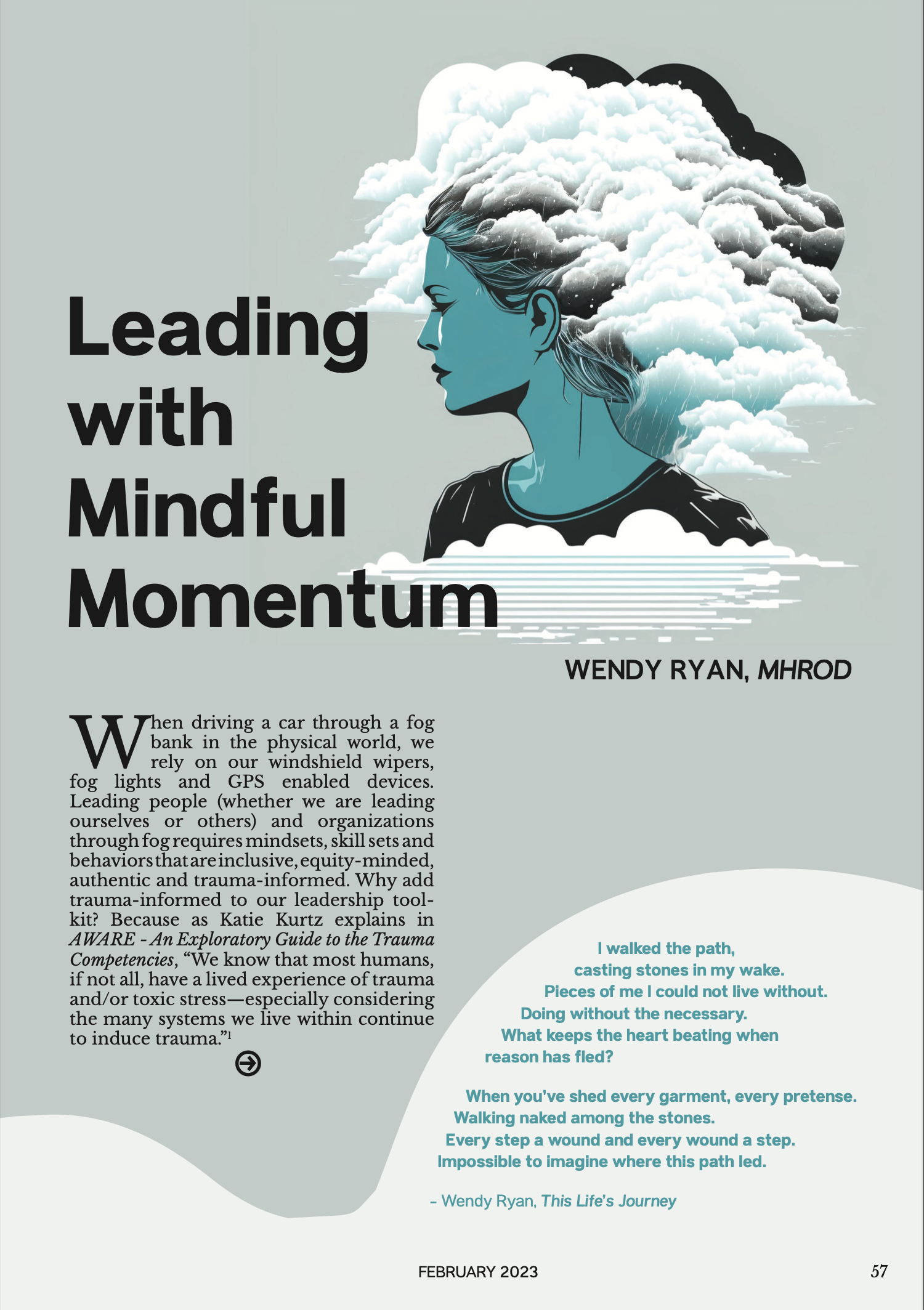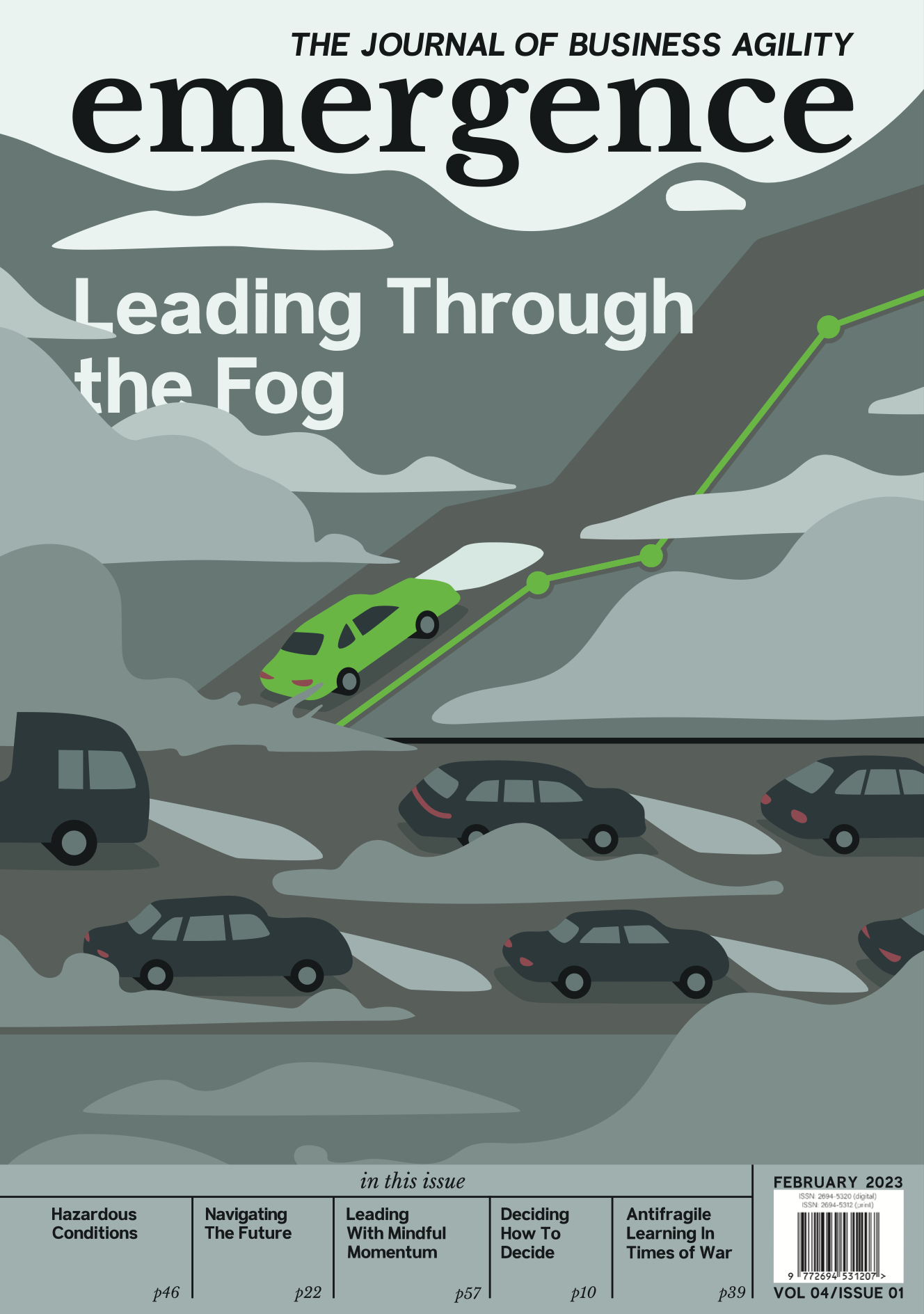Leading with Mindful Momentum
When driving a car through a fog bank in the physical world, we rely on our windshield wipers, fog lights and GPS enabled devices. Leading people (whether we are leading ourselves or others) and organizations through fog requires mindsets, skill sets and behaviors that are inclusive, equity-minded, authentic and trauma-informed. Why add trauma-informed to our leadership tool-kit? Because as Katie Kurtz explains in AWARE - An Exploratory Guide to the Trauma Competencies, “We know that most humans, if not all, have a lived experience of trauma and/or toxic stress—especially considering the many systems we live within continue to induce trauma.”[1]
I walked the path, casting stones in my wake. Pieces of me I could not live without. Doing without the necessary. What keeps the heart beating when reason has fled?
When you’ve shed every garment, every pretense. Walking naked among the stones. Every step a wound and every wound a step. Impossible to imagine where this path led.
- Wendy Ryan, This Life’s Journey
Interior Fog vs. Exterior Fog
There are two primary sources of fog we encounter in organizational life. The first we’ll call interior fog, which clouds up our personal windshield and makes it difficult, if not impossible, for us to accurately perceive and therefore respond optimally to events happening around us. While interior fog can stem from any number of sources, one of the most common relates to trauma. According to Katie Kurtz, “It’s important to understand that trauma is NOT the event(s) but rather the human response to that event(s). It can occur acutely (one time), chronically (complex), systemically, historically, ancestrally and/or vicariously.” Even when conditions are clear externally, interior fog can still wreak havoc on individuals, teams and their organizations.
The second source is VUCA, which is an acronym created by the U.S. military in the 1990s. VUCA stands for volatile, uncertain, complex and ambiguous—the conditions leaders encounter in battle-field conditions. Sound familiar? That’s because VUCA increasingly describes the conditions in which virtually every organization operates today. COVID-19, climate change, disruption of global supply chains and recent geopolitical realignment generate or amplify VUCA dynamics, which creates exterior fog.
Leading Individuals Through Fog
When interior fog originates from unprocessed individual or collective trauma, traditional leadership often responds to it by encouraging people to “grind it out” or “dig deeper.” In other words, ignore your pain and pretend it doesn’t exist while you are at work.
Often, trauma survivors internalize these messages. Instead of recognizing that their personal windshield is fogged from the inside and seeking the support they need to help clear the fog (e.g. counseling through their company’s employee assistance program (EAP)) they will work longer hours, take on additional tasks and direct their attention anywhere other than internally.
As our understanding of brain and nervous system functioning grows, we are beginning to appreciate how counterproductive this approach really is. A good analogy emerges when we consider that the application of leeches was once heralded as a go-to cure for a wide range of human ailments. As modern medicine has evolved, so has our understanding that for most medical conditions, bleeding people only makes them sicker.
Trauma changes brain and nervous system functioning in ways that can appear permanent because the changes tend to be both persistent and durable. It’s helpful to recognize the symptoms of trauma from two different perspectives:
- Symptoms the trauma survivor experiences, and
- What symptoms of trauma look like to others.
I’ll stare directly at the sun, but never in the mirror.
It must be exhausting always rooting for the anti-hero.
- Taylor Swift, Anti-Hero
A Survivor’s Perspective
Recently, my brother-in-law called me. He asked if would come as soon as possible to keep my sister company. She was at a medical facility that day receiving a chemotherapy infusion to treat cancer. “I know she told you last week when you offered that she didn’t want to subject you to sitting there with her all day, but she’s having a rough time,” he said.
Most of us experience a range of different emotions when we come face to face with a loved one’s serious illness or treatment. Fear, concern and anxiety are common. We may also notice physiological changes in tandem with those emotions such as sudden increase in our heart rate, rapid and shallow breathing, and breaking out into a sweat.
Like aftershocks following an earthquake, survivors of trauma may relate to some or all of the symptoms listed in Table A in response to stimuli we encounter years later. That stimuli may be a stranger or familiar person, a certain smell, taste, sound, visual or tactile sensation, an environment, or type of event. We can think of these as “fog triggers.”
Table A. Symptoms of Trauma from a Survivor’s Perspective
PHYSICAL
- My heart rate skyrockets and I hear it pounding in my ears.
- My mouth is dry, my throat constricts and it’s hard for me to swallow.
- My hands shake.
- I feel nauseated.
- I am light-headed and feel dizzy.
- I may pass out.
SOCIAL
- I often avoid events with large crowds.
- I feel unsafe, awkward or exposed in certain natural (e.g., parks) or built spaces or environments (e.g., conference rooms, offices) and with certain types of people (e.g., tall men).
EMOTIONAL
- I can shift from a state of relative calm to rage or tears in an instant.
- If something goes wrong, or I or someone on my team makes a mistake it’s very hard for me to move past it or forgive the co-worker who made the mistake.
- I need complete control over my work product. People describe me as a perfectionist.
COGNITIVE
- I prefer to do things myself because no one else can do it as well as I can or will take the same care to make sure it’s right as I will.
- I sometimes replay events or conversations over and over in my head. I get stuck in a kind of loop where it’s all I can think about.
- Under pressure my mind goes blank. I either can’t seem to remember what I was going to say or I can’t seem to formulate the right words to express my point rationally, so I go silent instead.
- I assume that people at work are talking about me behind closed doors and/or thinking negative thoughts about me.
My sister and I share a traumatic experience that occurred over a decade ago—the sudden illness and death of our mother due to complications from cancer-related surgery. Fast forward to the present, and we are both experiencing fog triggers during my sister’s cancer treatment. Some of our fog triggers, such as being in a hospital environment, receiving an unexpected phone call and a cancer diagnosis originate from the time of our mom’s passing. Some are newly emergent. The point is, more of our mental and emotional resources over the past several weeks have been directed toward regulating ourselves and leaving fewer mental and emotional resources available to invest in other endeavors than would typically be the case.
That human response can “...feel like a disconnection in your body and from your sense of safety, security and stability. Trauma can also feel like too much, too fast, too soon—overwhelming your nervous system to the point it makes it difficult to neutralize or regulate.” (Kurtz, 2022)
A Manager’s Perspective
Let’s say you are the Director of Engineering leading a large team of software developers for a rapidly growing SaaS business. You and your team members routinely put in long hours working both at the office and from home. The overall sense of urgency in the office to meet tight deadlines is palpable, and you find the constant hustle exciting and energizing. Lately, a few of your superstar team members have surprised you with their lackluster performances in meetings with VIPs and requests to work from home more often. One has called in sick several days in a row, which is atypical. You’re starting to wonder, what’s going on?
One possibility is that they are suffering from the effects of trauma related to chronic stress from overwork. Perhaps they recently lost a loved one or dear friend to COVID-19. Whatever the source, what can you do about it?
Table B. Symptoms of Trauma from a Manager’s Perspective
PHYSICAL
I notice that my team member has a strong, visible reaction (flushing, stammering, crying, yelling, pounding their fists on the table, throwing objects, etc.) to something I, a colleague or a client said or did and it seems significantly out of proportion or inappropriate considering actual circumstances.
SOCIAL
I notice that my normally articulate team member goes completely silent or underperforms in meetings, especially in front of my boss or other VIPs whenever they are asked questions.
EMOTIONAL
I wonder if I can trust this person and/or if this person is mature or stable enough to handle increased responsibilities.
COGNITIVE
I notice this team member spends way too much time “in the weeds” and sweating over minor details even though they have a staff of capable people who should be doing it instead.
What’s Going On?
Trauma disrupts normal brain and nervous system functioning in at least three ways:
- First, it causes us to misencode information. In other words, if two people are sitting in the same meeting and hearing the same words being spoken by their manager, trauma may explain why they can interpret those words very differently. People who have suffered trauma are more likely to overgeneralize and/or to ascribe negative meanings from communications than those who have not.
- Trauma causes disintegration and disassociation between the brain’s executive and higher order cognitive functions and its emotional processing centers. The practical impact of disintegration can be a reduction in our emotional intelligence, specifically in the areas of self-awareness and emotional regulation.
- Finally,
trauma can cause us to become hypersensitized to various forms of sensory stimulation— noise, touch, odors, etc.—as well as hypervigilant—always scanning our environment for perceived threats to our status and/or safety. As Ryan Gottfredson explains, “We do not want to be caught unaware by a raging fire, but if we are unable to regulate every time we smell smoke, it will be intensely disruptive.”[2]
Stephen Porges’ polyvagal theory[3] provides a useful framework for leaders to understand people’s individual and collective responses to trauma. He identifies three basic gears or “states” inherent to our nervous systems. Through the polyvagal lens, we understand the manifestation of a trauma response as a person’s nervous system getting “stuck” in only one gear instead of fluidly shifting between gears the way it is designed to in order to smoothly propel the car (us) forward.
So, once this happens, how does a person become “unstuck?”
It’s important for individuals who have experienced trauma as well as their bosses, family members, friends, and colleagues to understand that thanks to neuroplasticity some of these changes can be mitigated or even reversed with appropriate treatment. Intervention and support, therefore, matters. Additionally, symptoms of trauma can mimic or mask other conditions.
Post-traumatic growth describes a phenomenon where instead of people returning to a baseline level of functioning following treatment, they emerge more resilient and capable than they were prior to the trauma occurring. We aren’t yet able to predict who is more likely to experience post-traumatic growth, but as research on post-traumatic growth continues it’s important that we recognize trauma is a highly personal and individual experience and that not all outcomes are negative.

Leading Organizations Through Fog
Sometimes, our first instinct is to reverse course to avoid moving through the fog. (Retreating) Leaders make statements such as, “It’s time for us to get back to basics,” or to “tighten our belts.” Anytime I hear the phrase “We need to get back to” something, it’s generally an indicator that leaders are attempting to tame VUCA by recreating systems that worked for them in the past. Unfortunately, that rarely works because those systems weren’t designed to operate in VUCA contexts.
For example, during pre-COVID times, most people working in corporate professional roles did not work remotely on a routine basis. Today, a significant portion of the corporate professional segment of the workforce works remotely at least one day per week. Organizations that have attempted to either coax (or in some cases demand) workers return to the office five days per week have discovered that the in-office Monday to Friday is no longer desirable or realistic for many.
Other times, we may decide that hitting the gas and moving as quickly as possible through the fog is the way to go (Accelerating). Clearly, there are some downsides to taking this approach. Accelerating our way through VUCA assumes we can manage it. The reality is, we can’t know for certain or predict far enough in advance how many potholes lie ahead and how far apart they’ll appear, how many hills we will need to climb or precisely how long it will take us to achieve results in the future similar to what we’ve achieved in the past. Because the context or landscape is shifting in ways we don’t yet recognize and won’t show up on GPS, we are as likely to careen off a steep cliff as we are to make our way through the fog any faster.
For example, many early-stage companies in their startup phase race to get their product to market and capitalize on what is commonly referred to as the “first-mover advantage.” As product development cycles get shorter and shorter thanks to advances in technology, there is increasingly a risk that adequate testing, controls or quality control can’t be maintained. Two famous examples of founders whose pursuit of these shortcuts caused tremendous harm to their customers and investors are Elizabeth Holmes, founder of Theranos, and Sam Bankman-Fried, founder of FTX.
Another strategy is to park the car and let the engine idle while we wait for the fog bank to dissipate (turtling). If we do nothing at all, our logic assumes, we can simply resume our journey at a more convenient time. The problem here is that people, including our most talented staff and valuable customers, might decide to exit our vehicle in favor of hopping into someone else’s. Passivity kills the engine when we run out of gas.
Large organizations tend to be most at risk for turtling in response to exterior fog when instead they could be leveraging their considerable human and financial resources to leap ahead and out of the fog. When survival isn’t top leadership’s immediate concern, like it often can be with smaller organizations, it can be all too easy to justify maintaining the status quo. Universities and other traditional educational institutions come to mind as sectors that have been too slow to innovate despite clear signs that they are not on a sustainable path.
A fourth (and in my view, the only viable) approach is to choose to move forward through the fog via a series of shorter, successful journeys, pausing along the way to process current conditions, reassess and reorient ourselves, integrate our key learnings, adjust our forecasts and continue on. We call this Mindful Momentum.
A recent example of mindful momentum can be seen in the re-emergence of Microsoft Corporation as a dominant service provider in both software and hardware-based computing. Microsoft’s current CEO Satya Nadella led a massive cultural shift that successfully pulled Microsoft out of turtling mode and into mindful momentum. A key factor in this shift was Nadella’s insistence that company leadership learn and practice non-violent communication4 as a necessary first step. Eventually, Microsoft was able to navigate through a paralyzing fog created by internal toxic hostility and infighting and back onto a path of constructive decision making and innovation. Two core tenets of non-violent communication that Microsoft successfully employed at scale which we would recognize as trauma-informed are:
- Centering empathy and compassion in our interactions with others, and
- Distinguishing and valuing observation (noticing what is) apart from evaluation ( judging good or bad).
My sister and I are actively applying some of the strategies associated with mindful momentum on our journey through her cancer treatment. For example, after the phone call from my brother-in-law, I took the action of canceling all meetings and rearranging my commitments on the remaining dates when her chemotherapy has been scheduled. That way, I can be fully present with her and tend to my own physical, mental and emotional health on those days.
My sister has curtailed her work schedule and is focused on self-compassion—being as productive as her body and brain will support while recognizing that some days are better and some are worse. Throughout each day, she takes frequent breaks to assess how she is feeling physically and mentally and how much energy and focus she can muster to complete the next task. This is a new and different way of navigating work and life than my sister’s typical “nose to the grindstone” approach.
We both recognize the privilege we hold in being able to adjust our work schedules and commitments without penalty. Were our circumstances different, our experience would be even more challenging. It’s an important reminder that successfully integrating trauma-informed practices requires a simultaneous focus on equity and inclusion both in public policy-making and in organizations.
As business owners, we sometimes forget that the menu of choices available to us when we are driving through the fog is different from the menu of choices—real or perceived—that our team members may have available to them. Equity in a trauma-informed context means that people are able to access what they need in order to navigate interior fog without being penalized for it, whether that requires no organizational support, some support or a lot of support.

Conclusion and Recommendations
If you suspect that trauma is generating interior fog for you or some of your team members, or if you’d like to integrate trauma-informed practices more broadly in your organization, there are a number of first steps you can take.
Individual and Team-Based Strategies
- Prioritize psychological safety as the key enabler for team performance. People managers and team leaders are in the best position to facilitate 1:1 and team-based interactions that are psychologically safe and in so doing, to increase their team’s productivity and performance over time.
- Integrate pauses into your meeting agendas and norms. Always schedule breaks and solicit requests for ad hoc pit stops that may be needed during meetings. Pauses enable all individuals to access the time and physical space they may need to clear their windshields when they start to fog and are necessary for mindful momentum. If it feels counterintuitive to slow down or take a break when you are under time pressure, remember that you won’t achieve mindful momentum without frequent and deliberate pauses.
She visits me from time to time. I never thought she would be mine, To keep.
- Wendy Ryan, Grace
Organizational Strategies
Trauma disrupts normal brain and nervous system functioning in at least three ways:
- Educate stakeholders about VUCA and personalize communication to them regarding how you are building org capacity to meet their needs in a more dynamic operating environment. What this looks like in practice is personalizing your communications by 1) getting to know your stakeholders well enough that you understand their needs and concerns, and 2) tailoring your communications to convey VUCA principles in the context of what is most relevant to them and their expectations.
- Encourage your leaders to model authenticity in the workplace. Think, “We have to contain ourselves but the container we use should be as flexible and transparent as we can stand.” Leaders who do this well “go first” and practice selective self-disclosure around their own identities, personal challenges, what strategies they are using to cope and how that impacts their leadership. What this looks like in practice is leaders regularly sharing not just their wins, but also losses, regrets and lessons learned across all communication channels— all-hands meetings, online forums, and 1:1 interactions.
- Pay attention to the flow of talent and identities moving into, up and out of your organization. Typically, there are discernible patterns that HR data will illuminate for specific teams and departments where inclusivity merits greater focus, commitment and accountability on behalf of leadership. Organizations who leverage this type of data well build talent inclusivity reviews into their quarterly business reviews right alongside their financials. Inclusivity manifests when a critical mass of people experience a strong enough sense of equity and belonging within the organization. Diversity is only one building block to achieving that. You can have broad diversity across many categories in an organization (e.g., race, gender identity, sexual orientation, neurodiversity, etc.) but be sorely lacking in equity and inclusivity. For example, if 50% of the people working in your organization identify as people of color but you don’t have a single person of color on your board of directors or your leadership team, that sends a strong signal to people internally and externally that equity and inclusivity are not high priorities.
- Name and integrate trauma competencies as a pillar of your performance evaluation system, manager development programs and leadership succession criteria.
Every team member should receive basic training on the experiences and symptoms of trauma and be held accountable to respond in trauma-sensitive ways to other staff members and customers. Models such as the Trauma Competency Framework™ (Kurtz, 2020) can help you define which specific skills and competencies are needed for each role in the organization and embed relevant skill building and certifications throughout the talent lifecycle.
In summary, leading people and organizations through fog requires mindsets, skill sets and behaviors that are inclusive, equity-minded, authentic, and trauma-informed. Though it may have provided you with a deep well of compassion for others suffering the effects of trauma, the reality is that being a survivor of trauma does not on its own grant you the necessary knowledge and skills for you to navigate interior or exterior fog well. As the first step in any successful journey is awareness, consider exploring one of the recommended resources provided at the end of this article to start building your personal trauma navigation toolkit as a leader.
This content was originally published in the February, 2023 Edition of Emergence, The Journal of Business Agility. It has been republished here with the permission of the publication.
What is Emergence?
Emergence is the Journal of Business Agility from the Business Agility Institute. Four times a year, they produce a curated selection of exclusive stories by great thinkers and practitioners from around the globe. These stories, research reports, and articles were selected to broaden your horizons and spark your creativity.
Recommended Resources
Online Education and Training
- https://thetraumafoundation.org/
- AWARE Guide by Katie Kurtz
- CULTIVATE (Trauma-informed space-holding training)
- PV-Informed Certification for Organizations
Books
- The Body Keeps the Score by Bessel van der Kolk
- What Happened To You? by Bruce D. Perry and Oprah Winfrey
- My Grandmother’s Hands by Resmaa Menakem
- The Elevated Leader by Ryan Gottfredson
References
- Kurtz, K. (2022). AWARE - An Exploratory Guide to the Trauma Competencies
- Gottfredson, R. (2023). The Elevated Leader, Morgan James Publishing
- Vu, L.H. & Muller, R. (2022) Polyvagal Theory: An Approach to Understanding Trauma
- When CEO Satya Nadella took over Microsoft https://www.businessinsider.com/microsoft-satya-nadella-nonviolent-communication-2018-10








